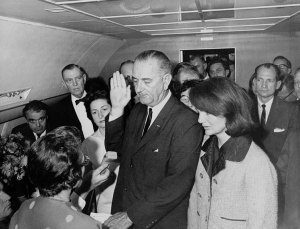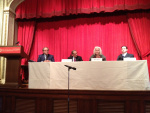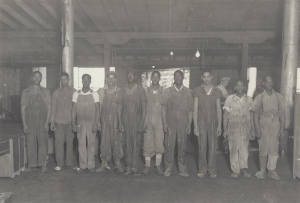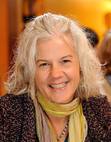Beth Macy's Blog, page 2
June 10, 2013
What Would Robert Caro Do? (I finally got to ask.)

From the back cover of a reporter’s notebook, where I tape reminders on story structure, Caro-style digging and other inspirations.
Twenty-six people were featured in the iconic Air Force One photo of Lyndon B. Johnson being sworn in as President of the United States. Standing next to him was Jacqueline Kennedy, just 43 minutes after her husband was pronounced dead.
The prize-winning journalist Robert Caro, who’s spent four decades chronicling the 36th president in a series of acclaimed biographies, had examined the records and talked to most all of the 26 people on board the plane that day, many of them multiple times. Then it hit him: After thousands of interviews about Lyndon Johnson, after decades of archives-combing, he’d never thought to interview the photographer who’d taken the picture.
So Caro found himself calling the Florida home of 89-year-old retired White House photographer Cecil Stoughton, praying he wasn’t actually calling Stoughton’s widow.
“My name is Robert Caro, and I’m writing books on Lyndon Johnson,” he told Stoughton’s wife, nearly 50 years after the photograph was made.
“Oh, Mr. Caro, Cecil has been waiting for your call.”
Caro, the two-time Pulitzer winner, brought down the house with that bit of meta-journalism during a recent panel on book-writing organized by the Lukas Prize Project, a joint project of the Columbia School of Journalism and the Nieman Foundation for Journalism at Harvard. I was in the catbird’s seat, sitting on the dais between Caro, who’d just won the Mark Lynton History prize for “The Passage of Power,” the fourth of his five planned LBJ books; and Andrew Solomon, who’d won the J. Anthony Lukas Book Prize for “Far from the Tree: Parents, Children, and the Search for Identity.” Still a month from turning in my own work of narrative nonfiction, I was there for “Factory Man,” which had won the J. Anthony Lukas Book-in-Progress Award.
What would Robert Caro do? I had asked myself that question numerous times during the writing of my book about globalization and a struggling Virginia furniture-maker named John Bassett III, who’d taken on China and a tidal wave of corporate greed to save hundreds of jobs.
Now I had a chance to ask Caro that in person. The question had already sent me on a quest to interview an 86-year-old ambulance driver about an EMT call he’d made 30 years before. (Caro’s editor, who was seated in the audience, told me she roared at hearing that story.) It had sent me kayaking — white-water rafting, actually — down Virginia’s Smith River, which is 42 degrees year-round if you want to know. (Oh, I know that intimately, after plunging in head over tree branch.) It had sent me back to some of the same subjects over and over again, resulting in new material every time and my own new insights on prompting memories and, maybe more importantly, a subject’s genuine trust.
At the start of my project, I had taped a quote from Caro on the outside of my notebook: “There is no one truth, but there are an awful lot of objective facts, and the more facts you manage to obtain, the closer you will come to whatever truth there is,” he told a Time magazine interviewer last year.
I had 11 months to complete my manuscript, not a decade, which is what it took Caro to turn in his fourth, 700-page installment. His pace is so methodical and slow, The New York Times’ Charles McGrath has pointed out, that it’s taken Caro longer to write about LBJ’s years in power than LBJ spent actually living them. Among the things I learned during the hourlong panel:
Caro makes detailed outlines, which he types on an old Smith Corona Electra 210 then pins to the walls of his Columbus Circle office, near New York’s Upper West Side. The very first thing he does is write a two-sentence to two-paragraph summary of each book — all the better to authoritatively digress from your theme if you know intimately what your theme is.
He does better when he has a last line in mind, something he can aim toward. The moment Caro heard the subject of his first biography, Robert Moses, tell an audience that people weren’t sufficiently grateful for his work, it occurred to Caro exactly how he would end his seven years of research into the life of the urban planner who built and bulldozed much of New York — with the line: “Why weren’t they grateful?”
Similar to Caro’s tracking down the 27th set of eyes aboard Air Force One, Andrew Solomon spoke about the process of trying to court the parents of Columbine shooter Dylan Klebold for his book about children who are markedly different from their parents, including kids who are cognitively, physically and psychologically impaired. Solomon’s book is full of bitter truths and surprises but always from the perspective of a journalist who is proud to bear witness to the “shimmering humanity” of parenting.
Respectfully but persistently, Solomon kept asking for interviews, even when the original response had been no. He corresponded with Sue Klebold for two years before she agreed to meet him for coffee — only to cancel at the last minute, saying she and her husband had changed their minds. Solomon told her he’d already purchased the nonrefundable ticket from New York to Colorado for their meeting — whether that was true or not, he didn’t say (I got the sense it wasn’t). But the Klebolds finally relented out of guilt, and ended up talking to him for seven hours during their first meeting alone.
They were thrilled that, finally, someone was more interested in understanding them — including the things they loved about their son — rather than judging them.
Solomon allowed himself to be moved, letting the emotions of his characters drive the theme of his book and the contextual reporting, not the other way around. His structure developed around the idea of what it’s like to parent profoundly different children, but he let his characters shape the final form as he winnowed 25 potential stories/interviewees down to ten over the course of 11 years.
“I tried to be awake to the possibility that the stories I was hearing were going to maybe change from what I thought I was writing,” he said. “I wasn’t trying to find the stick figures to back up points I’d already thought up. But I hoped that by talking to large numbers of people and [using] a more inductive process, I could get to the point of having my idea take shape around the people.”
In fact, he didn’t fully delve into the intellectual armature of the book until he was five years into story gathering mode. “I always thought if you ended up writing the book your proposed, it probably wasn’t worth investigating,” he said.
Friends asked me later what it was like meeting Caro, one of my heroes. He’s friendly and at the same time distant, putting his hand on your arm when he talks to you but volunteering — in a way that beats you to the punch — that, alas no, he does not blurb other writers’ books. (Fair enough, I thought, given that he’s in his late 70s and still has that fifth LBJ book to write.)

From left: Moderator Nicholas Lemann, Robert Caro, Beth Macy and Andrew Solomon
When I had a minute alone with him at the end of the evening, I asked how he might handle a sticky ethical issue I’ve been wrestling with for several months. “I don’t know, but I sure am looking forward to seeing what you do with that!” he said, beaming his bright-white smile and shaking my hand one final time.
Then he was off to hail a taxi with his faithful research assistant and wife, Ina. He had made a point to share the glory, asking her to stand up as he accepted his award, noting that she did not complain when they had to sell their house to help finance an earlier book. Throughout his career, Ina Caro was the only one he trusted enough to help him with research.
My friends and I headed to a bar while they waited for their cab. And I thought of another bit of advice I’d taped to my notebook at the start of the project, sent by my storytelling mentor Mary Bishop, in the form of a poem by David Whyte. While it’s good to take inspiration from the masters, the real magic happens when you find your own way into a project and develop your own Caro-like work ethic, starting with the genuine sound of your own voice and “the ground you know, the pale ground beneath your feet.”
[image error]
The last stanza of David Whyte’s “Start Close In”


December 13, 2012
The Book Slog Blues (Part II)

Furniture departments were segregated in Southern factories until the 1970s. This is Stanley Furniture’s rub room in the late ’20s or early ’30s. Photo courtesy of Coy Young.
The more I learn for my book-in-progress, the more I am humbled by how stupid I was when I wrote my proposal for “Factory Man.” I actually told my editor at Little, Brown & Company that I was halfway through my reporting, when in fact that figure was probably closer to 5 percent.
I wasn’t lying when I said it. I had just forgotten the central tenet of good writing: It’s all about great reporting. The more you learn, the more you realize you didn’t know anything before.
What do I wish I’d known before I started writing my book five months ago, after 20-some years of pining to land a book contract?
The connection-making mind needs frequent breaks. It needs mid-afternoon walks up Mill Mountain and breaks to make chili verde, and it craves any help and inspiration it can unearth along the way.
So I tape things to my computer, and atop the notebooks I carry with me on interviews. I write down nice things my book writer pals say to me, such as these aptly incongruent affirmations from Roland Lazenby: “You’re fucking fearless” and “Don’t be scared.”
I read and reread things like this partial paragraph from a profile of hip-hop pioneer Ahmir Khalib (Questlove) Thompson, written by New Yorker writer Burkhard Bilger:
. . . He had an unending appetite for pop culture, a prodigious memory for dates, and a compulsion for cross-referencing them. He can tell you, for instance, that Philadelphia police bombed the MOVE headquarters on May 13, 1985; that Tony Orlando guest-starred on “Cosby” that month, and that “Soul Train” was a rerun that week.
Stand back and look at the contextual heavy-lifting accomplished in just two sentences. Marvel at the astonished, easy tone. Count the status-defining details — where the subject lived, what he watched, who he listened to and what it meant to live inside his brain in the spring of 1985.
John Updike once said we like characters like Becky Sharp and Mr. Quilp because “what we like is life — and if the character is alive, we don’t apply any other criteria.” That’s another inspiration I’ve clipped, with thanks to Martin Amis, who recalled it in an interview with Vanity Fair writer John Heilpern.
The deeper you dig into a subject’s history, the tougher the material-culling will be. I’ve never spent this much reporting time focusing on one industry through one person and, the truth is, we might both be suffering from interview fatigue.
In a one- or two-shot interview, you save the tough questions for the end. But what do you do when the interviews are spread over more than a year? You spread the tough stuff out and hope for the best.
I’m not writing a hagiography, I remind my main character. I’m not writing a biography. So let’s put an end to the embedding jokes about Paula Broadwell and General Petraeus right now!
I’m writing a book about globalization in which he is a heroic main subject but he’s not a saint because, let’s face it, he’s colorful, he’s clever, and he seems to genuinely care about the plight of his factory workers. But he ain’t a saint.
When I worry that maybe I’m stirring up stuff that should remain hidden in history’s dusty archives, I turn to the new U.S. poet laureate, Natasha Trethewey, who said this in a recent interview:
It is better if we grapple with [history]. Openly and honestly. And include parts that are difficult. … When the Birmingham church bombing convictions came down, people on the radio were saying, why open old wounds? The problem with that thinking is assuming those wounds had healed. Some bones broken will forever be weak. They will ache and cause pain. The best we can hope for is acknowledgment. What drives me crazy is when people don’t want to acknowledge!
I try to keep central in my mind: I may be writing about wealthy CEOs, but I’m also writing about their impact on tens of thousands of displaced factory workers whose stories are too rarely told.
“Factory Man” contains both history and current events, encompassing a decade of double-digit unemployment in Martinsville, Va., the recent sweatshop fires in Bangladesh and Pakistan, and what life was like for a bunch of hardscrabble sawmillers in 1902. The subject is as deep as it is wide and meandering, and that’s what keeps me awake so many nights because I know that finding exactly the right narrative, and the right tone to tell it in, are crucial.
So I write and, like the old sawmillers-turned-furniture men, I try to cull the good wood from the bad. I talk to people on the phone and I visit people, and then I talk to them again on the phone. I’ve driven from nursing homes to trailers to communities so exclusive that they purposely don’t show up on GPS.
I read through court transcripts, annual reports and simplistic old newspaper clippings.
I love, love, love the librarians and the curators, especially Pat Ross at the Bassett Historical Center, and Bill Bishop, the genius at the International Trade Commission who returns my late-night emails — by 6:45 a.m. And people like Bassett barber Coy Young, who just happened to have a stack of archival photos from Stanley Furniture during the Depression.
I really love, love, love my across-the-street neighbors Scott and Jean, who just yesterday brought me a mixed CD and homemade chicken soup to cure my strep.
My husband, Tom, is so patient with all my non-cooking and non-hygiene, he’s the real saint of my book. My son Will comes into my office at the end of his school day and still, at age 14, beams, “Hey mom, how was your day?”
Same as it ever was. I practice Ass In Chair and, for several hours a day, I try as I type to weave story from facts. I rarely take showers or leave the house, except to walk the dog up the mountain. I haven’t seen my hairdresser in six months and it shows.
I worry because I know what Robert Caro says is true:
There is no one truth, but there are an awful lot of objective facts, and the more facts you manage to obtain, the closer you will come to whatever truth there is.
I was lucky to stumble into coffee not long ago with Internet journalism guru Clay Shirky, whose parents live in Roanoke and who very kindly offered to read my draft and give feedback. Just as I’m lucky to call on writers like Roland, Annie Jacobsen, Bret Witter and Andrea Pitzer, who advised me to “start recruiting readers now!” — among many other useful things.
Such has been the ongoing lesson I’ve learned from this project, this career, this life: The more exceptional the individual, the more generous they tend to be in sharing what they know.
It had been awhile since Shirky’s heralded book, “Here Comes Everybody,” was published by Penguin, and initially Clay said he had no advice to offer. Then he remembered a tip, a nuts-and-bolts editing suggestion that is applicable to both writing and life.
When the publisher’s copy editor sends his or her edits, simply click “ACCEPT ALL.” It saves time in the long run, and if you stumble on a change you don’t like as you’re reading, you still have time to make that sentence sing.
I’m not sure my ego will let me ACCEPT ALL blindly without previewing the changes first, but if it gets my butt out of this chair a moment sooner, it could be just the thing.

What do Elvis, Louis Philippe dressers and Dalian, China have in common? They’re all featured in this maze of scribbles that is my whiteboard outline for chapter 17.


December 7, 2012
A** in Chair, Audra and Advice from the Other Side of Publication (Part I of II)
 My friend Audra Ang came to visit recently. She’s a former Beijing correspondent for the Associated Press, and a fellow Nieman who is as committed to eating good food as she is to getting the story exactly right. We were happy those two things converged when she came here to read from her brand-new book, “To the People, Food Is Heaven: Stories of Food and Life in a Changing China” (Lyons Press, 2012).
My friend Audra Ang came to visit recently. She’s a former Beijing correspondent for the Associated Press, and a fellow Nieman who is as committed to eating good food as she is to getting the story exactly right. We were happy those two things converged when she came here to read from her brand-new book, “To the People, Food Is Heaven: Stories of Food and Life in a Changing China” (Lyons Press, 2012).
In the spring of 2010, I witnessed the moment when the idea for the book first floated from her mouth, at a brainstorming session that was part of a book publishing conference organized by our narrative writing teacher, Connie Hale, at Harvard’s Lippman House. (Connie wrote a wonderful post about her own book tour trials here.) So it was fitting that Tom and I hosted Audra’s first reading, a gathering that probed everything from the wonders of hotpot to the paranoia of reporting in a society where the press isn’t exactly free.

The audience was rapt, especially when she read about covering the earthquake.
A Western-educated Singaporean of Chinese descent, Audra is someone who makes everything look easy, from her “dude”-peppered speech to her Michelle Obama arms. It’s also one of the wonders of reading her book, which flows seamlessly from scenes of her walking over earthquake rubble in Sichuan, knowing that dead bodies lie beneath her, to choking up as she shares a meal with earthquake survivors. For people who don’t know much about the world’s most populous nation and its next superpower, her book is a fantastic introduction to all things Chinese.
Now halfway through my own book project, I had hoped to suction some lessons from my Nieman pal since she’s a year ahead of me in the process. What did she wish she had known in the beginning that she only came to learn through 12 tactile months of Ass in Chair days that usually began when she awoke at 2 in the afternoon and went to sleep at 8 the next morning, with food and yoga/kickboxing breaks in between?
“Dude, writing a book aged me,” she said. Hauling around seven years of notebooks on multiple trips between the Bay Area and Singapore didn’t help her back, either.
Then came the worst news of all from the Other Side of Publication. Audra suggested I back up my material up on multiple spare hard drives as well as in the cloud. (Yep.) Keep copious track of my copious notes. (Yep, I was doing that already, too.) And find early readers who are brutally honest about what works and what doesn’t. (I’m jealous that she had Ted Anthony, AP’s feature writing guru, to call on for help — though I’m grateful that journalist-writer friends including Clay Shirky, Andrea Pitzer and Leigh Anne Kelley have already volunteered their red pens.)
It was my worst fear realized. There are really no real magic bullets beyond sitting my ass in my chair, followed by more Ass In Chair, interlaced with copious amounts of hand-wringing and back spasms. And remember the way the old-fashioned typewriter used to sound when you dinged the carriage that final time on an article? (For you young folks, you know, like the secretary babes do on Mad Men?)
Duuuude, it’ll be a year before you even get to imagine hearing that sound. (I’m not sure what Audra did for her sore back, but I recommend those peel-off icy/hot pack stickers and, if you have one, a nightly hot tub accompanied by a book that has nothing to do with what you’re writing about so you won’t find yourself dreaming about, in my case, legal transcripts from the International Trade Commission.)
I read on a hand-me-down Nook my aunt gave me, which is backlit — great for night-tubbing — and mostly impervious to steam, as long as you hold it an inch or so above your head. Sadly, this does not take the place of a daily shower. There was a week not long ago when I wore the same sweaty yoga pants for four days.
Writing her book on the heels of a rigorous six-year reporting stint in China wiped Audra out so much that she’s happily taking a break from journalism, working as a senior development writer at Duke University — and still eating unseemly amounts of food in a single setting, though the potstickers and pork belly have given way to buttermilk biscuits and Cajun-infused deep-fried turkeys.

She’s not joking when she says she eats unseemly portions in a single sitting. Where does it go?
We had the privilege of introducing our foodie pal to our favorite restaurant in the world, a hillbilly-Asian place that is a tiny speck of funk in the rolling hills of Tazewell County. Cuz’s Uptown BBQ co-owner Yvonne Thompson took us on a serious food bender that included Rappahannock oysters, crab cakes with chili hollandiase, Thai seafood curry, plate-sized prime rib and coconut crème brulee — and that’s literally only about half of what we ate. When we left our Cuz cabin the next morning, we carried baggies of leftover country ham.
Dude, welcome to the South!
Audra claims she’s stuck a fork in her storytelling career. This, from a reporter who once offered to cut off her arm in exchange for a tour of an illegal noodle-making operation. But that’s her story right now, and she’s sticking to it.
(I’ll post Part II of my Advice from the Other Side of Publication — featuring more advice I’ve been collecting from writers — in a few days. Meantime, if you have your own book-writing tips to share, please chime in.)





